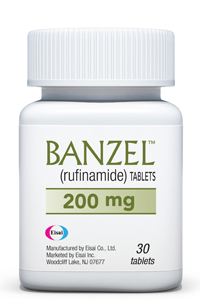Product
Banzel
Approval Date
Nov. 14, 2008
Release Date
January 2009
Company
Eisai
Class
Triazole derivative
Indication
Banzel is indicated for adjunctive treatment of seizures associated with Lennox-Gastaut syndrome.
Active Ingredient
Refinamide
Agency Roster
AbelsonTaylor
Intouch Solutions
Marketing Strategy/Execution
Banzel is a triazole derivative that is structurally unrelated to currently marketed AEDs. It is believed to exert its effect by regulating the activity of sodium channels in the brain which carry excessive electrical charges that may cause seizures. The effectiveness of Banzel as adjunctive treatment for the seizures associated with Lennox-Gastaut syndrome was established in a single multicenter, double-blind, placebo-controlled, randomized, parallel-group study which showed a 42.5 percent median reduction in frequency of drop attacks, seizures that cause a person to lose consciousness and fall to the ground, compared with a 1.4 percent median increase for placebo-treated patients. Drop attacks are a primary cause of injury in LGS patients.
Physician Outlook
Refinamide (generic name) or Banzel has just been approved for the adjunctive treatment of seizures associated with Lennox-Gastaut syndrome (LGS) in children 4 years and older and adults. This product should be available to patients as of January 2009. Although this is not a widely know drug among Neurologists with only a 15% awareness, well below the GfK Market Measures benchmark of 34%, this is a specialized and severe form of childhood epilepsy where this drug should provide improved relief for patients. It has a structure that is unrelated to current AEDs and is believed to reduce the excessive electrical charges in the brain that may cause seizures. The label includes a suicide warning but we do anticipate at least initial success for Banzel.
— Kim Lazarus, Vice President, Neurology, GfK Market Measures
Also in the Pipeline (courtesy of Adis R&D Insight)
Drug: Clobazam
Manufacturer: Ovation Pharmaceuticals
Indication: Lennox-Gastaut syndrome (Adjunctive treatment)
Active ingredient: Clobazam
Phase:III
Source: Wolters Kluwer Health
Pharmacology
Lennox-Gastaut syndrome is a seizure disorder characterized by multiple and frequent seizures. The onset usually occurs in patients 1 to 5 years of age. Symptoms include several seizure types such as tonic, atonic and absence seizures. Atonic seizures lead to sudden falls known as “drop attacks”, a primary cause of injury. Tonic-clonic, myoclonic and other seizure types can also occur. Rufinamide is a novel antiepileptic agent that is unrelated to currently available antiepileptic drugs (AEDs) . It has been shown to prolong the inactive state of sodium channels, but its precise mechanism of action in treating seizures is unknown.
Clinical Trials
A study was conducted to evaluate the effectiveness of rufinamide as adjunctive therapy in the treatment of seizures associated with LGS. The study enrolled patients 4–30 years of age with inadequately controlled seizures (including atypical absence and drop attacks) who were taking 1–3 concomitant stable dose AEDs and who had at least 90 seizures in the previous month. Following a baseline stabilization phase, either rufinamide or placebo was added to the therapeutic regimen for 12 weeks. The primary efficacy variables were the percent change in total seizure frequency per 28 days, the percent change in tonic-atonic seizure frequency per 28 days, and seizure severity (a parent/guardian global evaluation of the patient’s condition). Results of the study indicated that patients given rufinamide had a significantly greater reduction in total seizure frequency and in frequency of tonic-atonic seizure along with improvements in the seizure severity rating from the global evaluation.
Adverse Reactions
Somnolence, fatigue, incoordination, dizziness, gait disturbances, ataxia, headache, GI upset, visual disturbances, leukopenia, fever/rash (monitor for multi-organ hypersensitivity reaction).
Adults
Take with food in 2 equally divided doses. Initially 400–800mg per day; increase by 400–800mg/day every 2 days to target of 3200mg/day. Avoid abrupt cessation (reduce dose by 25% every 2 days).
Children
Take with food in 2 equally divided doses. <4yrs: not recommended. =4yrs: initially 10mg/kg per day; increase every other day by 10mg/kg to target 45mg/kg per day or 3200mg/day (whichever is less). Avoid abrupt cessation (reduce dose by 25% every 2 days).
Contraindications
Familial short QT syndrome.
Precautions
Severe hepatic impairment: not recommended. Mild to moderate hepatic impairment. Dialysis (may adjust dose). Depression or suicidal ideation (monitor). Pregnancy (Cat.C). Nursing mothers: not recommended.
Interactions
Caution with drugs that shorten QT interval. CNS depression with alcohol, other CNS depressants. Antagonizes carbamazepine, lamotrigine. May potentiate phenobarbital, phenytoin, triazolam. Potentiated by valproate (reduce doses). Antagonized by carbamazepine, phenobarbital, primidone, phenytoin. May affect substrates of CYP3A4, CYP2E1 (monitor). Antagonizes hormonal contraceptives (use non-hormonal forms too). May be affected by inducers or inhibitors of carboxylesterases.









